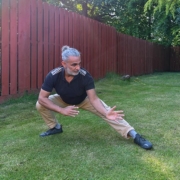What’s your relationship to learning?
WHAT’S YOUR RELATIONSHIP TO LEARNING?
This blog follows on from my blog on martial arts as a lifelong practice where I discussed researching martial arts gyms and connecting with Muay Thai communities in Thailand. Here I will share some of my learning journey and invite you to reflect on your own relationship to learning, whether it be within the martial arts of some other practice or endeavour.
Having practiced and taught martial arts for almost three decades years, I’ve always admired and sought out those who had committed to many more years of practice than I had experienced. I was fortunate to have been first introduced to Wu-Cheng Tai Chi Chuan, by Tom Hendrie, a former Judoka or Judo player who was well versed in the grappling and throwing aspects of the art. Tom was a student of Ian Cameron, who first studied with Cheng Tin Hung in Hong Kong in 1971 and after returning to Edinburgh taught up until the early 2020’s – over 50 years of dedicated practice and teaching. This is very rare nowadays and his unwavering commitment to his own practice and teaching has led to a rich community of practitioners in Edinburgh having the privilege to learn, in-depth, the five aspects of tai chi chuan: hand forms, pushing hands, martial applications, weapons and nei gung.
Whilst tai chi chuan is and always will be the main martial art I practice, I have enjoyed immersing myself in learning other martial arts over the years. When you have a background focusing one art form, there is a process of giving up what you think you know to embrace other styles and teaching/learning styles. This is a concept which we work on with in our tai chi practice – to invest in loss. Whilst the term can be understood martially in terms of giving yourself up to your opponent in order to, “lead them into the void”, before counter-attacking, it also has the spiritual dimension of letting go of your ego or the need to win or be in control. To be receptive to a new art and teachers/trainers is a humbling experience, one that takes you out of your comfort zone, which when embraced, challenges you and opens you up to new possibilities.
Within competitive martial arts, fighting is never pretty, and Muay Thai fighting is as brutal as it gets. If you ever watch a Muay Thai tournament you will see what I mean. The injuries sustained is one of the main reasons why many fighters retire in their twenties. At my age I’m not interested in getting involved in hard sparring or competing, but I am always interested in practising effective training methods and enhancing my striking techniques. Last time I studied Muay Thai was at the Tiger Muay Thai gym in Phuket in 2010, where I ended up injuring my back doing group classes. This can often happen when you push yourself without awareness of your own body and movements. It also happens when working with some training partners, who have no idea of the concept of mutual learning. Some just want to compete at all costs without any care or consideration for their partners. I remember training in Jiu Jitsu when I lived in Brighton and having my rotator cuff torn, a result of an inexperienced partner who didn’t know when to stop putting a lock on and my own inexperience (and pride) to know when to tap out.
Muay Thai trainers have their own approach to learning – some on technique, conditioning, specialising in certain strikes or styles of fighting. Some of the specialist styles include, Muay Tae (strong kicks), Muay Femur (technical) and Muay Khao (knee). Some of the key areas I focused on on with Kru Beaw, a Muay Khao stylist and senior trainer at Rittisak Muay Thai in Koh Phangnan, included:
1. Warm ups – most lessons would begin with 5 minutes skipping, shadow boxing, followed by 5-10 minutes led stretching, where you would prepare all of your body (muscles, tendons and ligaments) to function well during the arduous training to come and to minimise the risk of injury.
2. Footwork – distance is central to applying techniques effectively. For example, there is a big difference between the distance between you and your opponent when applying a front push kick versus an upward elbow strike. Also, forward and backward side steps are commonly used to evade attacks whilst you counter-attack.
3. Pad and Bag Work – having a good trainer who knows how to hold pads are an important part in building striking skills. Hitting pads helps to develop power, speed, accuracy and co-ordinated strikes/movements, e.g. a left jab followed by a straight right and right knee or kick to the body (depending on distance). Bag work is used to develop power and resilience. At the end of every session, I would do 100 front kicks followed by 100 knees (50 left and 50 right) on the heavy bag.
4. Warm down – If 200 kicks and knees on the bag wasn’t enough, there was another three sets of 20 sit ups and 10 press ups along with battle ropes and picking up and throwing a medicine ball. Repetition is key to developing discipline, whole body strength and working through your own perceived mental and physical limitations. To address this, Beaw would stand at the side of me counting each strike or stand on my feet when I did sit ups to make sure I wasn’t taking any short cuts.
It was through my previous experience of sustaining injuries, that I learned the importance of conditioning. Nothing fully prepares you for the intensity you will face when you go into new training environments where the focus is on developing competitive fighters, but having a basic level of strength and endurance goes a long way. Before heading to Thailand I continued working on my tai chi practice, whilst incorporating high intensity training routines, running/cycling to develop cardio and endurance, weight training for building strength and stretching for flexibility and recovery. Being conditioned certainly helped, as well as creating a balance between training and resting/recovery, which I will speak more about next time.
What is your relationship to learning and how do you invest in loss?






